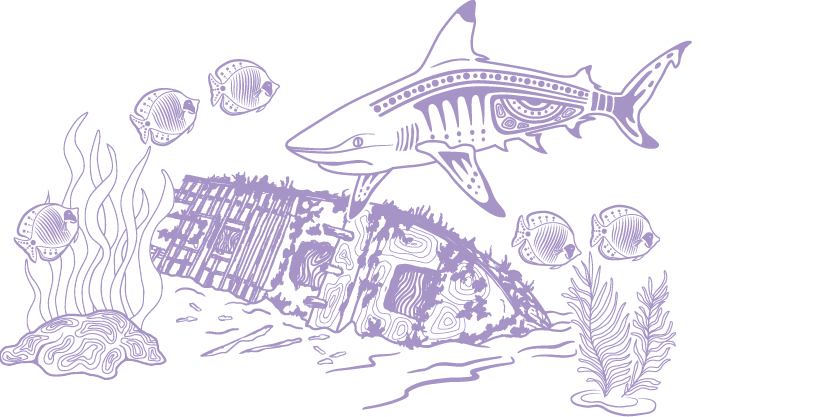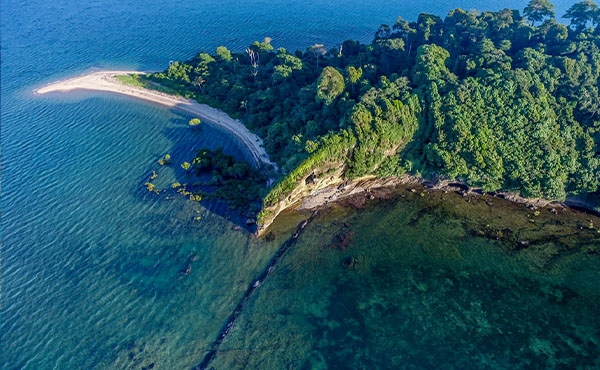First Nations peoples have diverse knowledge, language and social systems that have fostered technologies and culture for more than 50,000 years.1126,1127 Many of these tools and technologies remain an important part of the living heritage of First Nations peoples and continue to be used today. At the end of the last ice age, significant changes in sea level placed many older cultural sites below current sea levels. Now submerged archaeological records represent human occupation of the continent until 7000 years before present, but this record remains largely undiscovered.15,1128
Evidence of the capacity to plan and make open-sea voyages lasting several days has been shown to have been possible at least 50,000 years ago.1129 This capacity also extended to the use of visually prominent landscape features for navigation and an ability to locate freshwater to maximise survival in new lands, including the Region.1130 Through ancient maritime networks, northeast Australian First Nations communities were intimately engaged with peoples, knowledges, and technologies across the Coral Sea region.1117,1131
Scientific technology, including radiocarbon dating, provides insights as to the age of recently uncovered artefacts.1132 For example, pottery sherds uncovered on Lizard Island (Jiigurru) are the oldest securely dated ceramics found in Australia (Box 4.1).1117 Likely manufactured on the island, they reveal an ongoing connection with Melanesian peoples of the Torres Strait and New Guinea for at least 2000 to 3000 years.1117,1126 A variety of locally sourced and manufactured quartz artefacts have also been found on the island.75 Periodic yet sustained exploitation of marine resources on Jiigurru (Lizard Island) appears to have occurred over at least the past 5790 years.75,1113,1117 Evidence also suggests the knowledge of food plant cultivation in Torres Straits may have extended into northern Australia.1133
Box 4.1
Jiigurru and new ways of working
Working with Traditional Owners, western scientists have studied changes in the ancient environment and human history of Jiigurru (Lizard Island) over decades. This is a unique collaboration between the Dingaal Traditional Owners of Jiigurru, and a consortium of experts from Australian universities and research organisations. The collaboration has been an ongoing opportunity to nurture and empower cultural recognition of the Traditional Owners, in community and to the broader Australian community.
“We’ve been learning a lot about western science and they have been learning and adapting to our ways too,” says Gareth Deeral (Jiigurru Traditional Owner).
There are many middens (sometimes very large campsites of food and settlement remains such as marine shells and bones for fish and turtle) on Jiigurru, that were built up over thousands of years. They tell rich stories of ‘thousands of ancient feasts.’
They are stories of “peoples who traded technologies and lore, creating song lines and connections across the seas,” says Professor Ian McNiven, an anthropological archaeologist at Monash University.
The pottery sherds found on Jiigurru are highly symbolic and show the influence that may have been brought in from neighbouring communities and countries. It highlights the movement of people, goods and ideas across the Coral Sea at least 2000 to 3000 years ago, and that ancient Australia was not closed to outside influences. However, the scientific analysis on the sherds reveals that they were made from local materials, which shows that the technologies were here, and that First Nations people made the sophisticated vessels.
“The influence may have come from somewhere else but those old views that ‘anything sophisticated must have come from elsewhere’ are still represented in discourse about Australia’s First Nations peoples. There haven’t been thousands of sherds found here so this might represent very restricted use in this area,” Professor McNiven says.
A small sample can tell a big story. Whether it’s a water sample, a fish bone fragment, a shell, or a rare pottery sherd, the scientific knowledge that emerges from these analyses can provide so much information about what Sea Country may have been like, how it may have changed. Synergy and connection between First Nations knowledge and stories and western scientific methodology signal a new way of working between cultures.
Gareth notes the partnership is a respectful and mutual one, with research lead, Professor Sean Ulm, anthropological archaeologist at James Cook University, meticulously following cultural protocols and custom, engaging with Traditional Owners and Elders to establish a respectful and deep two-way understanding.
Source: Caring for Sea Country — Traditional Owner Stories from the Great Barrier Reef 1
Pottery sherds uncovered on Jiigurru are the oldest ceramics found in Australia
Boomerangs, originally considered by researchers to be solely a hunting tool are now considered to have a multifunctional role, including fighting, digging, making music, and retouching of lithic (stone) tools.1134 The integrity of coastal archaeological deposits is compromised by a history of changing sea levels, climate change, cyclones, storms, tsunamis and contemporary human impacts, which present complex challenges for the identification and conservation of these sites.1127 Despite these challenges, research into coastal midden complexes in central Queensland has provided insights into the history of changing human use of the coastal landscapes and resources of this area.120 Limited other archaeological work has been reported in the Region since 2019.
More than 179 fish traps and weirs have been documented across Queensland, with most in the Region comprising singular, arc-shaped rock enclosures typically located at points and estuaries.1135 Stone arrangement complexes are frequently found on the Australian mainland and islands, such as the two kilometres of looping u-shaped stone structures and adjacent stone middens documented in the Narrows near Gladstone.1136 These complexes are associated with ceremonial and ritual activities.120,1137 In Far North Queensland, some stone arrangements have Melanesian, Torres Strait Islander and Aboriginal influences, indicating cultural connections beyond the Region.1131,1137 Fish traps and other structures located within and adjacent to the Region may be affected by rising sea levels.1110
Although there have been some improvements since 2019, most cultural heritage places often lack mapping and robust site monitoring programs for impacts to these sites. Knowledge of early settlement and migrations resulting from sea-level changes has increased significantly since the Outlook Report 2019.


